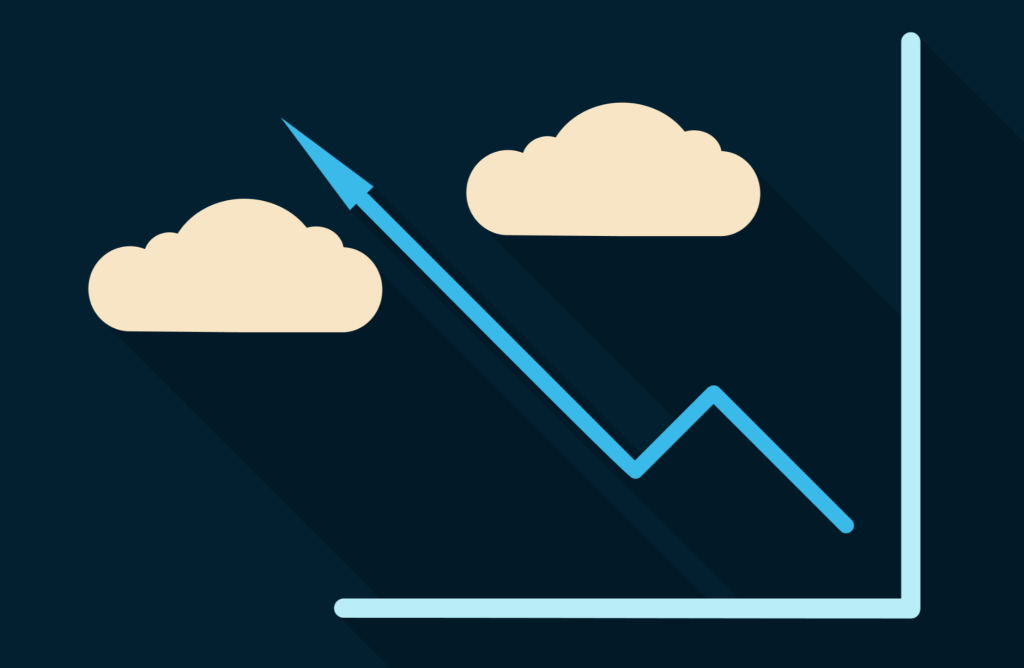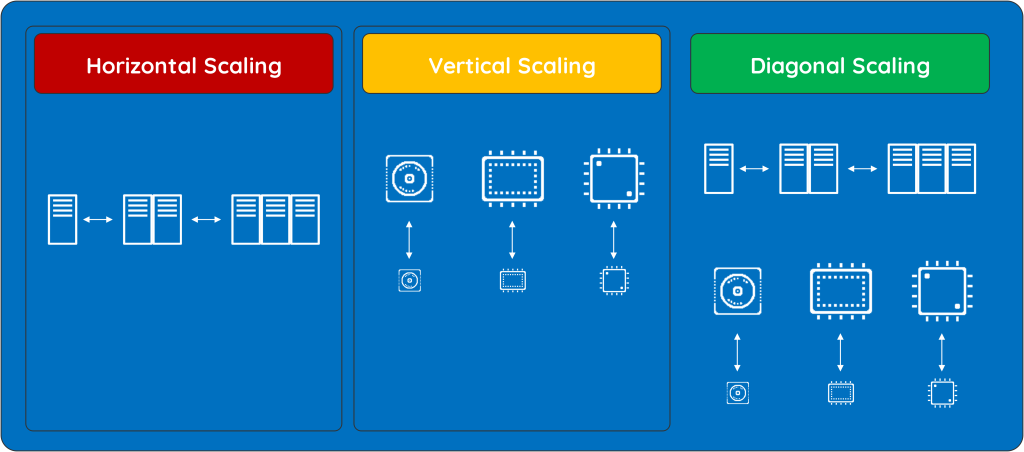Horizontal vs Vertical Scaling: Which is Best for Your Needs?
Developers

Some days in the office are slow, and some days are packed with end-of-month accounting tasks, rendering a bunch of video, or it’s batch processing time. Your computing needs can change from day to day, and your server capacity should be flexible enough to rise and fall with the demand. There are times when you need extra power, but you don’t want to pay for the heightened capacity all the time. Scaling is the answer.
There are three main options for scaling: horizontal, vertical, or a hybrid of the two, diagonal scaling. Let’s delve into the different strategies and their ideal usage across different solution types. Once you learn each technology’s benefits and limitations, you’ll be better positioned to decide which one is optimal for your organization’s needs.
What is Horizontal Scaling?
Horizontal scaling, also known as scaling out or in, refers to adding more nodes to a system to handle increased load. This method is similar to adding more lanes to a highway to accommodate increased traffic flow. In computing, these nodes could be additional machines, servers, or instances, each typically identical and sharing the workload. This approach is particularly prevalent in distributed systems like cloud computing environments.
The concept of horizontal scaling is central to modern distributed computing architectures. It’s widely used in systems where high availability, redundancy, and load balancing are crucial. In the context of web services, for example, horizontal scaling helps to accommodate sudden spikes in traffic by distributing the load across several servers, ensuring no single server becomes a bottleneck.
Advantages and Challenges of Horizontal Scaling:
- Flexibility and Scalability: Horizontal scaling offers exceptional flexibility in response to real-time demands.
- Fault Tolerance and Reliability: Horizontal scaling enhances system reliability by automatically compensating for the failure of one node.
- Cost-Effective at Scale: Organizations can pay for additional resources incrementally, rather than invest in significant hardware upgrades.
However, horizontal scaling introduces certain complexities. Systems must be designed to handle distributed architectures, requiring sophisticated software solutions to ensure data consistency and effective load distribution. There’s a need for mechanisms like load balancers to distribute requests among nodes evenly, and network latency and synchronization considerations become paramount. Additionally, horizontal scaling requires robust monitoring and management tools to maintain system performance and efficiency.
What is Vertical Scaling?
Vertical scaling, or scaling up and down, refers to improving the capabilities of a server by adding more resources like CPU, RAM, or storage. This method is like upgrading the surface of a highway to facilitate faster travel without increasing width. Vertical scaling is often more straightforward in implementation than horizontal scaling, as it typically involves upgrading existing hardware rather than integrating new systems.
Vertical scaling is the traditional approach to system expansion. It has been the go-to solution, particularly in legacy systems where adding new hardware or servers is impractical or impossible. Vertical scaling usually involves enhancing the server’s existing components, such as upgrading the processor, increasing memory, or adding faster storage solutions.
Advantages and Challenges of Vertical Scaling:
- Simplicity: Vertical scaling is straightforward in terms of implementation. It doesn’t require the complexities of managing a distributed system.
- Immediate Performance Gains: Enhancing a single server’s capabilities is optimal for applications that rely heavily on a single node’s processing power.
- Reduced Management Overhead: Without multiple nodes, vertical scaling avoids the complexities of load balancing and network partitioning.
The primary limitation of vertical scaling is its inherent ceiling. There’s a physical limit to how much a single server or node can be upgraded. Additionally, vertical scaling often requires system downtime for hardware upgrades, which can be disruptive. It also lacks the redundancy and fault tolerance provided by horizontal scaling, as the entire system depends on a single point of failure.

What is Diagonal Scaling?
Diagonal scaling, a concept that combines horizontal and vertical scaling elements, refers to a comprehensive approach to system expansion. This method involves adding more nodes to a system (horizontal scaling) and enhancing these nodes’ capabilities (vertical scaling). Diagonal scaling can be likened to a strategy where you increase the number of lanes and improve the road quality on a highway, accommodating more traffic and allowing faster travel simultaneously. This means adding more machines, servers, or instances and upgrading their hardware capacities in computing.
Diagonal scaling is a versatile and adaptive approach to managing system resources. It’s particularly effective in environments where the quantity of requests and the complexity or resource demands of these requests are increasing. By combining the principles of horizontal and vertical scaling, diagonal scaling provides a comprehensive solution to enhance system performance and capacity.
In practical terms, diagonal scaling might involve deploying additional servers to manage increased traffic (horizontal scaling) while upgrading their processors or improving their memory (vertical scaling). This approach is beneficial when a system needs to handle a larger volume of more resource-intensive tasks.
Advantages and Challenges of Diagonal Scaling:
- Enhanced Flexibility and Performance: Diagonal scaling combines the adaptability of horizontal scaling with the enhanced power of vertical scaling.
- Complexity and Cost Considerations: Diagonal scaling introduces greater complexity along with potentially higher initial costs.
- Resource Utilization and System Compatibility: It allows for balanced resource utilization across more powerful nodes.
When to Use Horizontal vs Vertical Scaling vs Diagonal Scaling
Horizontal scaling is best suited for systems that demand high availability, fault tolerance, and the capacity to handle variable and unpredictable workloads. Horizontal scaling is ideal for applications that can be efficiently distributed across multiple servers. It’s particularly beneficial in cloud computing environments where scalability, redundancy, and load balancing are critical. This method offers flexibility, as resources can be dynamically added or removed in response to real-time demands, making it an excellent choice for environments with fluctuating workloads.
Conversely, vertical scaling is more appropriate for applications that are challenging to distribute across multiple servers, or when a rapid scaling solution is necessary. This method is often favored for stable and predictable workloads, simplifying management by concentrating resources on a single server. Vertical scaling is straightforward, with immediate performance gains from upgrading existing hardware. However, it has limitations in scalability and introduces a single point of failure.
Diagonal scaling emerges as a versatile option, combining horizontal and vertical scaling benefits. It is suitable in scenarios where there is a need to add more nodes (horizontal scaling) and enhance the capabilities of these nodes (vertical scaling). This approach can be advantageous when dealing with increasing requests and simultaneously escalating resource demands of these requests. Diagonal scaling enables a system to handle a larger volume of tasks and more resource-intensive tasks efficiently.
Summary
Horizontal, vertical, and diagonal scaling are essential strategies in computing and technology, each with unique advantages and suitable application scenarios. Horizontal scaling is favored for its flexibility, scalability, and fault tolerance, making it ideal for distributed systems and cloud-based solutions. Vertical scaling offers a more straightforward, immediate upgrade path, best suited for smaller, predictable workloads. Diagonal scaling is the hybrid of the two, ideal for enterprises that encounter unpredictable spikes in demand.
Understanding the differences between these three scaling methods and their appropriate applications is crucial in designing systems that are effective in meeting current demands and capable of adapting to future growth and challenges.


